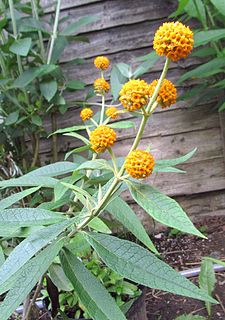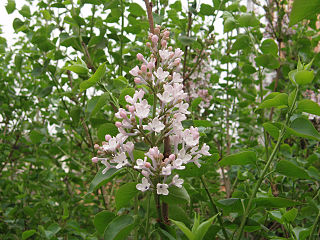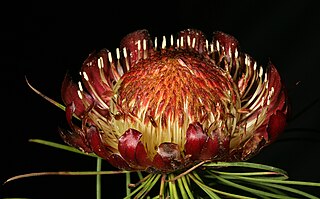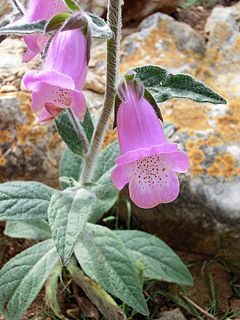
Quercus georgiana, the Georgia oak or Stone Mountain oak, is a rare deciduous red oak, native to the southeastern United States.

Tradescantia ozarkana, the Ozark spiderwort, is a species of Tradescantia. It is part of the Commelinaceae family, native to the States of Missouri, Arkansas, and Oklahoma in the south-central United States. It flowers from April to May and can be found in rich, rocky areas, including woods and bluff ledges.
Hopia obtusa is a species of grass commonly known as vine mesquite. This plant was treated as Panicum obtusum until recently when more molecular and genetic material revealed new information about it. Hopia obtusa is now placed in the monotypic genus Hopia.
Buddleja bhutanica is a species of flowering shrub endemic to Bhutan, where it grows in bush on mountain slopes at elevations around 1,700 m. The shrub was first described and named by Yamazaki in 1971.

Buddleja araucana is endemic to the semi-deserts and steppes of Patagonia, from southern Mendoza to Río Negro and Neuquen provinces in Argentina, and adjacent Chile. The species was first described and named by Philippi in 1873, it was introduced to cultivation by the British gardener and plant collector Harold Comber as a form B. globosa in 1925.

Syringa oblata is a species in the genus Syringa, in the family Oleaceae. It is also known as early blooming lilac or broadleaf lilac.
Syringa pinetorum is a species in the genus Syringa, in the family Oleaceae.
Chilocarpus conspicuus is a plant in the genus Chilocarpus, in the family Apocynaceae. It is native to Borneo. The only information known about this species is from a collection from Mt Kinabalu, Brunei and two collections from Sarawak. There are several similar species that are alike in flower and without examining the distinctive fruit of this species, a specimen may be mistaken for Chilocarpus denudatus. It is an accepted species, first described by Steenis and originally published in Blumea 19: 162 1971.

Penstemon arkansanus is a species of flowering plant in the plantain family known by the common name Arkansas beardtongue. It is endemic to Texas, Arkansas, Oklahoma, Missouri, and Illinois in the United States, occurring in rocky or sandy soils of shale or sandstone.
Pachystoma nutans, is a species of plant in the orchid family. It is endemic to Myanmar. It was first described by Sing Chi Chen and Yi Bo Luo in 2002. The type specimen of Pachystoma nutans was previously overlooked among unidentified Eulophia species at the Royal Botanic Garden herbarium in Edinburgh. It is only known from the type specimen, which was collected near Mong Yaw, Myanmar.

Hypericum formosissimum is a species of flowering plant in the family Hypericaceae, section Adenosepalum, in the Hypericum huber-morathii group.

Hypericum przewalskii, commonly called Przewalski's St. John's wort, is a flowering plant in Hypericumsect. Roscyna that is native to China.

Petrea volubilis, commonly known as purple wreath, queen's wreath, sandpaper vine, and nilmani, is an evergreen flowering vine in the family Verbenaceae, native to Tropical America, that is valued especially for its display of violet flowers.

Scaevola nitida is an erect shrub in the family Goodeniaceae, native to Western Australia. It grows to a height of 0.3 to 3 m, and its blue-purple flowers may be seen from August to December.
Wuodendron is a genus of plants in the family Annonaceae and tribe Miliuseae, containing the type and only species Wuodendron praecox. It is distributed from northeastern India north to southern China and southeast through most of Mainland Southeast Asia.

Protea pendula, also known as the nodding sugarbush or arid sugarbush, is a flowering plant of the genus Protea, in the family Proteaceae, which is only found growing in the wild in the Cape Region of South Africa. In the Afrikaans language it is known as knikkopsuikerbossie or ondersteboknopprotea.

Protea pityphylla, also known as Ceres sugarbush or mountain rose, is a flowering shrub of the genus Protea, in the family Proteaceae. The plant is endemic to the southwestern Cape Region of South Africa.
Protea decurrens, also known as linear-leaf sugarbush, is a shrub of the genus Protea, in the Proteaceae family, which is endemic to the southwestern Cape Region of South Africa. It is a small shrub with a thick underground rootstock, this structure throwing up numerous leafy branches, upon the base of which clusters of flower heads may appear close to the ground. It is pollinated by rodents and grows in low-altitude fynbos or renosterveld.

Digitalis minor is a species of flowering plant in family Plantaginaceae, which has been called dwarf Spanish foxglove. It is a biennial or short-lived perennial species of foxglove which is endemic to the Balearic islands with large, pendulous, pink or purple flowers. Closely related to the common purple foxglove, it is best distinguished by its small fruits. It is one of the only foxgloves to grow in calciferous, alkaline soils.
Strychnos nux-blanda is a shrub or small tree in the Loganiaceae family. It is native to Southeast Asia and Assam. The wood is used as fuel; seeds are toxic, but used in folk-medicine. It is one of the plants featured in the garden of King Narai (1633–88) at Lopburi, Thailand.











